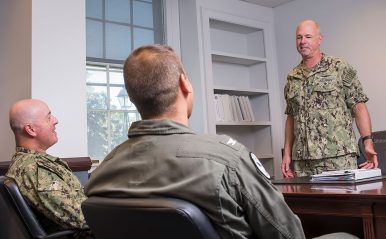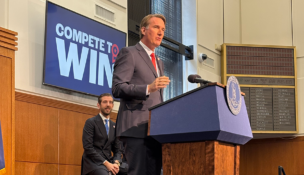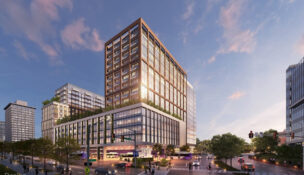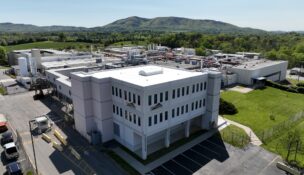Coming home
A Q&A with Navy Region Mid-Atlantic Commander Christopher “Scotty” Gray
Coming home
A Q&A with Navy Region Mid-Atlantic Commander Christopher “Scotty” Gray
As a kid growing up in Virginia Beach, “Scotty” Gray saw military aircraft so routinely that he wanted to become a pilot.
Today he is U.S. Navy Rear Adm. Christopher (still “Scotty”) Gray, commander of Navy Region Mid-Atlantic, where he oversees an area that stretches from Wisconsin to North Carolina and includes 14 installations — five in Hampton Roads — and nearly two dozen reserve outposts.
In Hampton Roads, Gray is responsible for as many as 90,000 active-duty personnel and another 52,000 civilian employees — as well as the world’s largest Navy base, Naval Station Norfolk, where as many as 72,000 military, civilians and contractors work.
He replaced Rear Adm. Charles “Chip” Rock, who retired in June.
Gray’s most recent post was commanding the Navy’s Europe, Africa, Central region, based in Naples, Italy. He also was a naval flight officer and deployed on the aircraft carrier USS Dwight D. Eisenhower. Additionally, he commanded the Norfolk-based Carrier Airborne Early Warning Squadron 124.
A graduate of the University of South Florida and a former investment banker before receiving his commission as a naval flight officer in 1989, Gray says he was a true “beach kid” who spent a lot of time fishing and surfing in Sandbridge.
In August, he spoke to Virginia Business about the Navy’s efforts to recruit and retain civilian and military personnel, as well as Future Base Design, a plan launched last year under which the Navy would lease desirable, underused land to private developers. About 400 acres in Virginia Beach’s 7,000-acre Naval Air Station Oceana is the first property offered for leasing.
Virginia Business: What are your priorities for the Navy’s presence in Hampton Roads, and what are the main challenges you face?
Gray: The biggest thing is making sure we can just continue to do our business. Frankly, we’re struggling in many areas. Security is first and foremost for us, and the pandemic and the COVID environment has made it very challenging.
Our model is based on a certain number of military folks and a certain number of civilian guards and/or law enforcement officials. We’re just much too close to the edge, where it could be impactful for us. The primary challenge is the pay has not been very good. We’ve hired at a level that has been low, where we get some interest but not very good interest. … We’re just getting ready to go out and try and hire at a higher pay grade. I’m hopeful that we will attract a lot more interest.
I’m taking a much broader look at how we leverage our underutilized resources and assets that we have here across this region … so that we can reinvest in ourselves. The infrastructure is very old, and it’s challenging us and our ability to maintain it. We’re seeing increased numbers of power outages and utility failures. I’d say that’s probably my second priority, because the Navy has chosen to underfund the shore for the benefit of the combat forces.
VB: What are some ideas you have for the Future Base Design plan, in terms of leasable property or in-kind swaps?
Gray: We’ve got lots of opportunities here. Down Hampton Boulevard, there’s … the South Depot Annex. It’s a piece of property that we’ve owned for years, and it’s smack-dab in the middle of the Port of Virginia‘s enclave there.
The Port of Virginia has expressed some interest in it because it is in the middle of its operation, and because it’s very valuable. It has a rail line into it, and it has warehouses that they could utilize. They have a piece of property that abuts the south end of Naval Station Norfolk. We could do a land swap. They could take those warehouses that are on that piece of property and build us a warehouse on the piece of property they have that abuts the south end, [and] they would get what they want. We would get some new warehouses and property that is adjacent to our existing structure, our base.
We’ve got the Lafayette River Annex. It’s just a beautiful piece of property on the water. We’ve got one headquarters there. I’d be perfectly willing to swap that to somebody, if they built me a five-story building on, or paid for some type of in-kind consideration on Naval Station Norfolk. I’d save all the expense of having to protect and operate a little separate enclave.
There’s St. Julien’s Creek Annex down in Chesapeake. We have some functions down there, but I don’t know that there [are] any that we couldn’t shift somewhere else — and that’s a lot of property on the waterfront that’s hard to come by these days.
I’m considering it all holistically, and we’re starting to talk to folks about all the potential opportunities, and we’ll begin to gauge interest. Where we find interest, we will look to pursue.

VB: Has there been any interest in the land at Oceana, which has been available since August 2021?
Gray: We’ve had some … consequential meetings with senior Navy folks, with the base, with some of the local military and community organizations. My impression is we’ve made some good progress. We have put out some requests for interest, which have received interest, which is encouraging.
Like anything that’s relatively new, especially when you have a large bureaucracy, the bureaucracy is resistant to change. You may get some new policy that says, ‘You can do this,’ but a lot of times [you’ve] got to go through many different stakeholders in the bureaucracy to get people to sign off on it — and what you find is resistance.
Those are the types of challenges that we face. If there’s one thing I would say that people would say about me, [it] is [that] I’m not afraid to bull through barriers.
VB: How have your conversations gone with local government and community stakeholders?
Gray: I’ve met with several local leaders, spoken to them in passing, [and] some of them in more than just collateral passing. I’ve attended a couple of local civic meetings. I’m still getting up to speed.
What I am communicating to them is: Let’s find ways to find win-win solutions to the problems that are facing the city and the problems that are facing the military.
I’ll give you a perfect example: If I have to buy enough trucks to plow snow here in Virginia Beach, where it only happens every now and again, then I’ve got millions and millions of dollars of equipment sitting around waiting for a contingency that may only happen a time or two a year. Why don’t I just make an agreement with the city to pay them a certain amount of money … to plow my streets on the base?
There [are] all kinds of opportunities like that. I could go down the list of probably 10 or 20 of those things.
VB: Retaining separating sailors to take skilled jobs is a huge goal locally, and this is a potential workforce for you. What efforts are being made by the Navy to keep veterans here?
Gray: First and foremost, I think we need to increase our agility and the ability to adjust to the market conditions, because we’re getting creamed at it right now.
Here’s another thing that on a broader scope that we need to take a look at: The state of North Carolina just passed a bill to make military retirement [pensions] untaxable. Well, guess what? North Carolina’s 50 miles from here. I know where I’m going — that’s a straight economic decision for me.
t

















